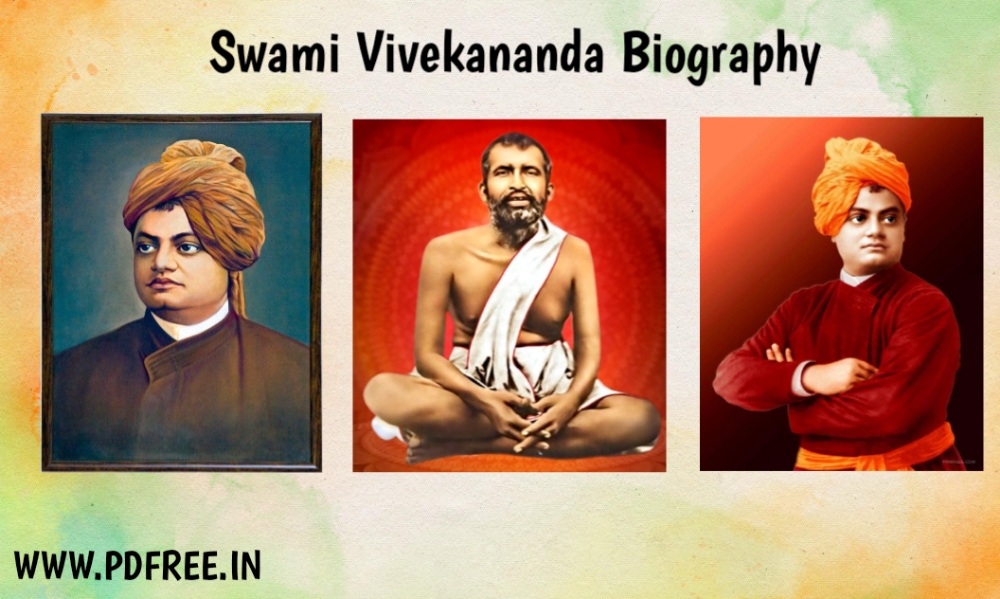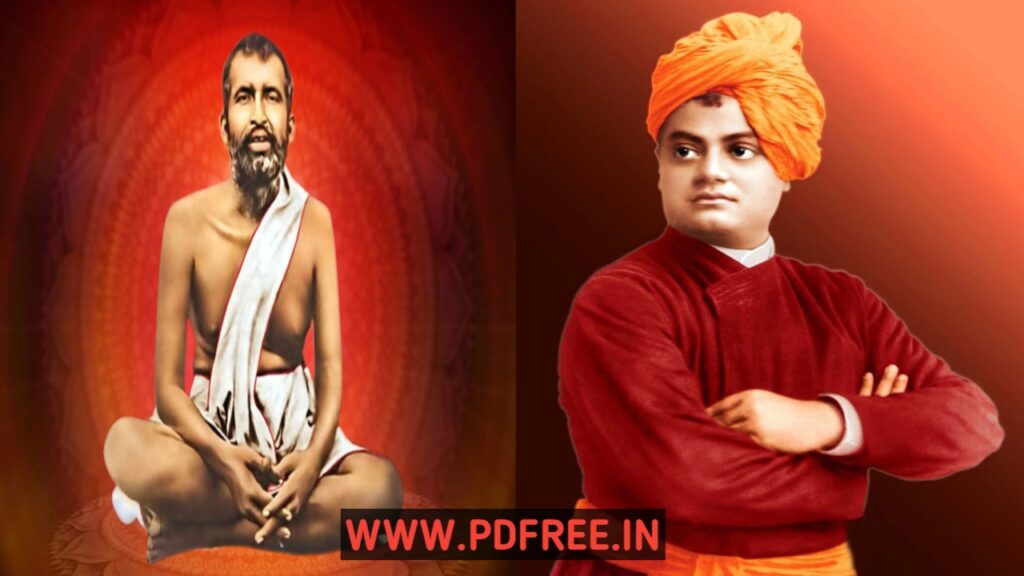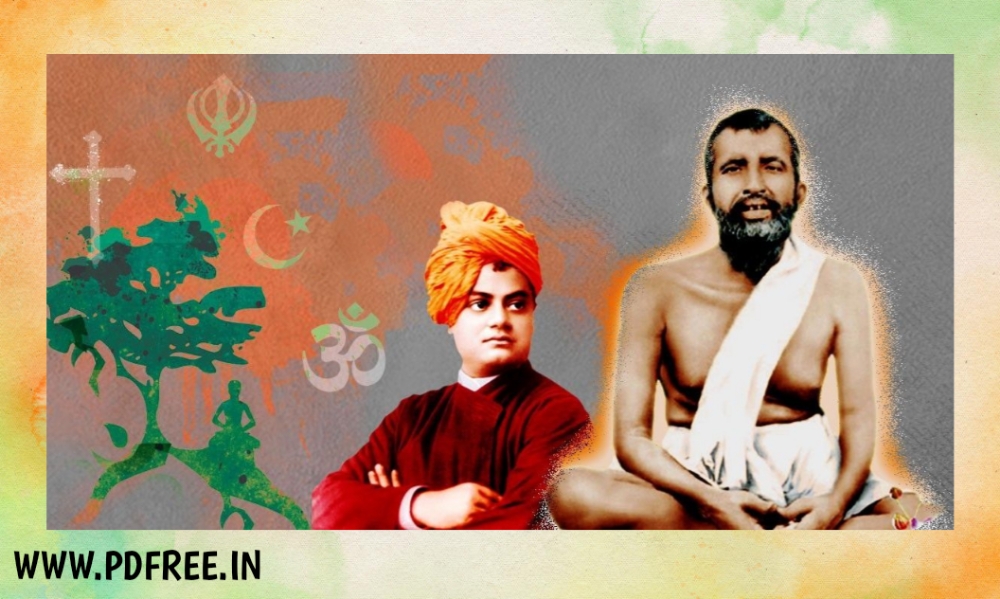Explore the remarkable journey of Swami Vivekananda Biography in English PDF. Discover the teachings, insights, and impact of this spiritual luminary who continues to inspire generations.

Swami Vivekananda Biography in English PDF:
The term Swami Vivekananda conjures up images of philosophical insight, spiritual awakening, and a tremendous influence on millions of lives. We go deeply into this illustrious person’s life and teachings in this comprehensive Swami Vivekananda Biography in English PDF. We explore the core of Swami Vivekananda’s journey, from his formative experiences to his early years.
Table of Contents
Swami Vivekananda Biography in English Pdf Details:
| Pdf File | Swami Vivekananda Biography in English Pdf |
| Size | 2.12 MB |
| Pages | 98 |
| Credit | Vivekananda International Foundation, New Delhi |
| Cost | Free |
| Last Update | 29 Oct 2023 |
Swami Vivekananda Biography:


Early Life and Family Background
On the auspicious day of Makar Sankranti, January 12, 1863, Swami Vivekananda was born into a Kayastha family in Kolkata. His mother, Bhuvaneshwari Devi, was a devout Hindu lady, while his father, Vishwanath Datt, was a well-known lawyer in the Calcutta High Court. There were nine siblings for Narendra. Persian and Sanskrit scholar Durgacharan Datt, his grandpa, made the decision to become a monk and leave his family behind.
Swami Vivekananda’s childhood name was Narendra Datt, and people affectionately called him Narendra. He was naughty and brilliant from an early age. He was more gregarious and liked pulling practical jokes when he was younger. He frequently studied and joked around with his classmates. Occasionally, he also dared to question his professors.
Read more: The Inspiring Journey of Dr. APJ Abdul Kalam Biography in English
His mother was a deeply religious woman, thus their home was filled with frequent religious rituals and readings of classic texts like the Ramayana, the Bhagavad Gita, and the Mahabharata. He had a strong desire to know God from an early age as a result of this upbringing. His parents once requested him to go seek answers from the Brahmins because they were eager for him to comprehend God. Leaving his family’s duties in their capable hands, he embarked on his voyage with his father in 1884.
Education of Swami Vivekanand
Home was the first place of education for Swami Vivekananda. He started elementary school at the Metropolitan Institution in 1871 at the age of eight, where he was taught by Ishwar Chandra Vidyasagar.
He and his family left for a year in Raipur in 1877 and returned home in 1878. He was the sole student to pass the Presidency College admission exam in Kolkata with the best possible score. He participated in athletics and academic competitions while attending college.
He received education in subjects such as philosophy, religion, social science, history, art, and literature.
Read more: Swami Vivekananda biography in Hindi PDF{स्वामी विवेकानन्द की जीवनी हिंदी में PDF}
He also studied thoroughly the Vedas, Upanishads, Bhagavad Gita, Ramayana, Mahabharata, and other Hindu articles. He was also trained in the classical music of India. He studied European history, Western logic, and Western philosophy while he was a student at Scottish Church College and Assembly’s Institution in Kolkata. He graduated in 1884 with a Bachelor of Arts.
He translated Spencer’s work “Education” into Bengali in 1860. 1984 saw him graduate from college after that. “Narendra is genuinely a highly clever individual,” the Mahasabha Institution’s principal wrote.
Despite all the locations I’ve been to, I’ve never encountered someone with his level of talent. He outshone even the philosophical students at the German university. That’s why they also called him ‘Shrutidhara,’ meaning a person with an extraordinary memory.
Meeting with Ramakrishna Paramahansa
From an early age, Swami Vivekananda was curious to know God. Then he said, “Have you ever seen God?” to the esteemed guru Devendra Nath. Devendra Nath was astounded to hear this question. Devendra Nath recommended that he should to Ramakrishna Paramahansa in order to satiate his curiosity. Following that, Ramakrishna Paramahansa was acknowledged as Swami Vivekananda’s teacher. He started to follow his guidance and go along the spiritual road.


Swami Vivekananda felt a great feeling of obligation and devotion to his master because of the profound impact he had on him. In 1885, his guru, Ramakrishna Paramahansa, was suffering from cancer, so Swami Vivekananda dedicated himself to his care, ultimately witnessing his guru’s passing. This strengthened the bond between guru and disciple.
Renamed as Ramakrishna Math
In twelve cities, Swami Vivekananda founded the Ramakrishna Mission when his mentor Ramakrishna Paramahansa passed away. Later, he renamed it Ramakrishna Math. He abandoned his family and adopted a life of celibacy, donning the ochre robes, after creating the Ramakrishna Math at the age of barely 25. That’s when he adopted the name Swami Vivekananda.
Vivekananda Swami’s visit to India
Swami Vivekananda traveled extensively on foot throughout India, stopping at locations including Varanasi, Prayagraj, Ayodhya, Banaras, Agra, and Vrindavan. He lodged at the houses of Brahmins, the impoverished, saints, and kings throughout this voyage. He experienced widespread prejudice and caste divides in the several places he traveled. Throughout his travels, he made great attempts to abolish the caste system.
On December 23, 1892, Swami Vivekananda reached the southernmost tip of India in Kanyakumari, where he meditated for three days. Following this, he travelled to Mount Abu in Rajasthan to meet his guru-brothers, Swami Brahmananda and Swami Turyananda. Witnessing the poverty and suffering of the people throughout his journey in India, he made the decision to work towards liberating the entire nation and changing the world’s perception of India.
Speech at America’s World Religion Conference
In 1893, Swami Vivekananda represented India at the World’s Parliament of Religions in the United States. This event brought together religious leaders from around the world, and each participant placed their religious texts on a table. India’s contribution was the Bhagavad Gita. When foreign attendees saw Swami Vivekananda, they made fun of him, but he remained silent and didn’t say a word. If you’re interested, you can find a detailed Swami Vivekananda Biography in English PDF to learn more about his remarkable life.
A journalist noted, “Despite the excellent speeches by scholars at the World’s Parliament of Religions, the Indian scholar managed to captivate the hearts of the entire American audience.” His various endeavors not only propelled him to newfound fame during that era but also established him as the world’s foremost scholar, a reputation that endures to this day.
Swami Vivekananda’s world tour
He spent three years in America following the World’s Parliament of Religions, during which time he preached Hinduism’s Vedanta at a number of locations throughout the nation. He was even acclaimed by the American media as the “Cyclonic Monk from India.” He then gave talks in Chicago, New York, Detroit, and Boston for two years.
Vedanta is an old Indian philosophical philosophy, and Swami Vivekananda established the Vedanta Society in New York in 1894 to propagate its teachings. Subsequently, in 1896, he participated in a noteworthy conversation on the life of his spiritual guide, Ramakrishna Paramahansa, with Professor Max Muller at Oxford University.
Establishment of Ramakrishna Mission
With an emphasis on fields like healthcare, education, colleges, and cleanliness, Swami Vivekananda founded the Ramakrishna Mission in 1897 with the intention of advancing modern India. He became a popular figure among the young people of that time due to his deep understanding of the Vedas, literature, philosophy, and history as well as his captivating personality.
Death of Swami Vivekananda
Swami Vivekananda passed away at the young age of 39 on July 4, 1902. His followers, especially ascetics, believe that he entered Mahasamadhi. The final rites for this great personality were performed on the banks of the Ganges River.
Conclusion:
Swami Vivekananda biography in English PDF is a biography of tribute to a visionary leader who kindled the flame of spirituality and enlightenment. His life, teachings, and legacy continue to inspire individuals on their path to self-realization and service to humanity. Explore his writings, speeches, and the profound impact he has left on the world, and let his message resonate in your life.
Friends, Take advantage of this chance to explore Swami Vivekananda’s universe and learn about the eternal knowledge he imparted to humanity. You will get priceless knowledge and motivation as you follow his adventure.
FAQs
What is Swami Vivekananda’s most famous quote?
Swami Vivekananda’s iconic quote is, “Arise, awake, and stop not until the goal is reached.” It encapsulates his call to action and unwavering determination.
What is the Ramakrishna Mission, and what is its purpose?
The Ramakrishna Mission is a philanthropic organization founded by Swami Vivekananda to serve humanity, provide educational support, and promote spirituality.